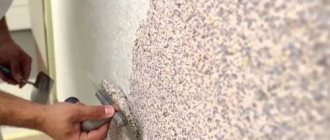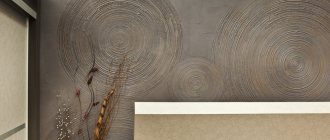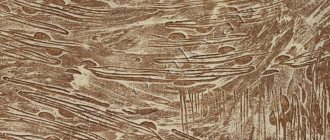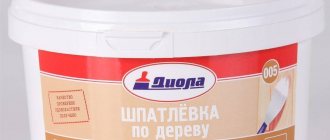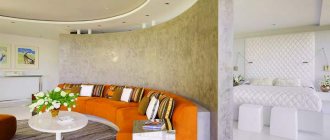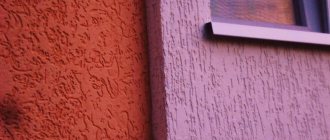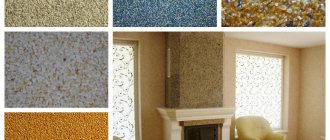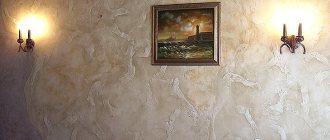Marble plaster is an interesting way to decorate a modern interior to create a luxurious design. The history of the use of this finishing material began in the days of ancient Rome. It was there that for the first time builders decided to use marble chips remaining after processing natural marble. This is how the famous Venetian plaster for decorating imperial palaces appeared. Despite the fact that many centuries have passed since then, decorative plaster with marble chips remains an effective option for wall decoration in our time.
Plaster composition
The material contains marble or granite chips, slaked lime, special binder fillers and mineral pigment. Creating a particularly durable coating is possible using a plaster mixture containing granite chips. If the plaster mixture contains two such important components as granite and marble, then the result is practical, high-quality granite plaster.
It is advisable to use this composition of granite-marble plaster to create the outer plinth of the facade or in places of high traffic, for example, in underground passages.
Types of marble plaster
Marble decorative plaster can be classified into the following types.
Functional purpose:
- Finishing of external facades.
- Creation of interior interiors of residential and public buildings.
Filler type:
- Exclusively marble chips.
- Marble chips with the addition of a granite component.
- Marble chips with lime.
- Acrylic with marble chips.
- Marble chips and cement-sand mixture.
Filler fraction size:
- Fine filler 0.8-1 mm.
- Medium with grain size 1-1.4 mm
- Coarse-grained with a fraction of more than 1.4 mm.
To get the desired visual effect from decorative plaster based on marble chips, you need to know the special technology for its application.
Marble plaster in the bathroom
Scope of application
Marble plaster is perfect for covering bases that need increased protection from water - plinths, facades, foundations. It is also used to decorate bathrooms, swimming pools, saunas, and baths. The material is plastic and is easily applied to products and surfaces with curves, therefore it is suitable for niches, columns, bay windows, ledges, as well as arches, openings, and any architectural forms.
Plaster with stone chips is widely used indoors. This type of coating is especially popular in cottages and houses with a classic, antique style. However, marble plasters also fit into modern style trends, allowing you to create fashionable details, patterns, and highlight walls or individual stripes or areas. As for base materials, plaster with marble chips ideally fits on surfaces that are not prone to shrinkage:
- brickwork;
- concrete, cement;
- foam blocks;
- cinder blocks;
- OSB, chipboard;
- drywall;
- plastered walls.
DIY marble plaster
The ready-made mixture is sold in any construction stores, but this does not mean that you cannot prepare a mixture for marble plaster with your own hands. Moreover, the price of a ready-made plaster mixture based on marble chips is quite high, it makes sense to make the mixture yourself.
To do this, you will need acrylic putty and two types of coloring pigment, as well as construction equipment: plastic buckets and a drill for mixing with a whisk.
First, the acrylic putty is thoroughly mixed with a mixer until smooth. The resulting mixture is divided into two parts and a certain portion of a coloring pigment of separately dark and light colors is added to each. The result should be a plaster composition that will stick well to the wall and not run off the surface.
There is another more complex recipe for how to make a composition for marble plaster with your own hands. You can prepare a variant of the mixture based on the following components: marble chips and slaked lime in an amount of 1100 ml, soap base 30 g, linseed oil 360 ml, water 180 ml and mineral pigment.
Step-by-step instruction
Before making marble from concrete, all the ingredients must be prepared because the process cannot be interrupted.
To produce artificial stone, technological operations are performed in the following sequence:
- Add 1 part cement and 2 parts fine sand to a clean container and mix evenly.
- Fill in filler - colored pebbles or pieces of marble.
- To achieve the desired color range from the marble composite, a coloring pigment is added. Most often, natural shades are obtained if the content of the coloring pigment in the volume of the working mixture is about 1%.
- After adding the additives, new mixing is performed. Spotty inclusions and imitation veins ensure complete identity of the artificial stone with natural stone.
- The container with the resulting mixture is placed on a vibrating table or platform and the equipment is started to compact the structure.
It takes 10 to 15 minutes of intense shaking to get a working composition without unnecessary air inclusions.
Then:
- A plasticizer is diluted in water (1% by weight of cement). The liquid is taken at the rate of 75% cement. Water and plasticizing additives are placed in the dry mass and mixed.
- Pre-cleaned polyurethane molds are filled with the resulting solution. If necessary, reinforcement is made with wire pre-cut to size.
After filling the solution, the molds are covered with polyethylene film and left for 10-15 days.
Color
To give artificial marble made of concrete the desired color, a coloring pigment must be added to the prepared solution. The composition should be heterogeneous to resemble a natural mineral. To do this, do not mix the solution too thoroughly.
To produce cast objects with unusual patterns, paints of several colors are used. During the mixing process, spots, dots, wrinkles, streaks and bends of various shapes are obtained, which give the product originality, limited only by the author’s imagination.
The total amount of pigment most often does not exceed 1% of the mass of the dry mixture. After introducing the dye, the solution is shaken using a vibrating table or manually.
Water
In relation to the dry component of the material, water is calculated 1:2. First, pour in 80% of the liquid and mix well. To increase the strength of the elements being created, at least 1% C3 plasticizer is added to the solution.
After further mixing and resting for several minutes, the finished material will become viscous and plastic. At the final stage, the remaining 20% of water is distributed throughout the composition.
Technique for applying homemade marbled plaster
Do-it-yourself marble plaster is not a fantasy at all. The main thing is to make up your mind and carefully study the application technique:
First step. The prepared mixture is scooped onto a spatula and applied in neat small strokes to the selected area of the wall, starting from the top corner. The strokes should not have gaps and should be applied with a spatula in different directions. Upon completion of work, the layer of mixture should dry.
The second step is to sand the first layer with sanding paper. Traces of sanding dust should be carefully removed with a soft brush. Next, you need to create an imitation of natural stone. For this purpose, you need dark-colored putty, which is applied with a spatula at an angle of about 30 degrees to the wall surface and spread in different directions. Chaotic application of strokes creates the desired marble effect. After this, the mixture layer should dry well.
The third step begins by applying a third thin coat of white mixture. The layer is applied very thinly, so that the dark mixture is noticeably visible. After drying, the surface of the third layer is sanded and smoothed with a metal spatula.
Upon completion of the work, the surface of the plaster is covered with a protective coating.
Preparing the walls
Before directly applying the finishing material to the walls, we must prepare the surface.
- First, we remove the old coating (paint, plaster, wallpaper, etc.) and each fastener element.
- We level the walls with starting and finishing putties, controlling the result using a building level and a plumb line. In cases where the unevenness is very large, I advise you to cover the room with plasterboard slabs and seal the joints using a putty mixture.
- We treat the surface with a double layer of primer with a break of at least 3 hours between applications of the primer. In this way, we clog all small pores and cracks, remove settled dust, increasing the adhesion strength of the plaster to the wall surface.
Technology of applying marble plaster
Marble plaster is applied using the ancient technology of Venetian craftsmen, which has remained virtually unchanged since those times. Depending on the desired effect, there are several methods for applying stone chip plaster. Coarse-grained compounds are applied evenly with a spatula over the entire surface without visible transitions or joints, “without lifting your hand.” In this case, the adjacent layers are not allowed to dry out. The coarse-grained mixture can be applied to ordinary “rough” plaster.
Mixtures of medium and fine fractions are recommended to be applied to smooth surfaces treated with a thin layer of putty and carefully sanded. The application of marble plaster occurs in several stages.
Preparatory stage.
At this stage, the surface on which marble plaster will be applied is thoroughly cleaned. Microcracks must be expanded and strengthened with reinforcing tape, and unevenness must be smoothed out with putty compounds. To remove dust from the surface, a deep penetration primer is applied. After drying, you can proceed to the next technological operation.
Second phase
Plaster based on marble chips is applied to a completely dry, flat surface. Coating of decorative plaster is done in the following order: Using a metal trowel and a stainless steel spatula, apply the plaster mixture with sharp strokes and carefully level it.
Half an hour after application, the mixture will dry out a little and then the surface is rubbed smooth with a polyurethane plastic trowel. To facilitate the grouting process, the plastic float is periodically moistened with water. If necessary, the surface of the plaster layer is also sanded.
The plaster layer is dried for two days. It should be noted that high-quality application of decorative plaster is possible at temperatures not lower than +5 degrees. If the temperature indoors or outdoors is lower, shrinkage cracks may appear on the surface of the plaster.
After the plaster has dried, apply the next layer, repeating all operations. For a high-quality coating, it is recommended to apply up to 7 layers of plaster.
After all layers have completely dried, you can proceed to the final process.
When done correctly, marble plaster creates an optical imitation of marble.
Third stage
The essence of the final stage lies in creating a protective coating of the finished marble plaster with wax, which creates a glossy silky effect. Ancient Roman craftsmen used real beeswax for these purposes, and in our time they use synthetic wax, which when applied gives a matte surface.
If desired, mother-of-pearl or sparkles are added to the marble plaster. Acrylic varnish applied in several layers can be used as a protective coating. This treatment perfectly repels dust and creates a waterproof coating.
Video tutorial on applying marble plaster:
Calculation of material quantity
On each package of plaster, the manufacturer indicates the consumption per square meter. This indicator is approximate and in practice may vary depending on the quality of preparation of the base, the skill of the performer, etc. Mixtures with round grains have a slightly lower consumption than those containing grains with edges.
Also, consumption varies depending on the grain size itself:
- large fractions - up to 8 kg/sq.m. m;
- medium fractions - 4–5 kg/sq. m;
- small fractions - 2–3 kg/sq. m.
On average, the thickness of the plaster layer is 5–30 mm (for street work it needs to be thicker). Using the specified data, you can calculate the material consumption and purchase the required quantity with a small margin.
Colored shimmer of marble plaster
Colored decorative marble plaster can have a large palette of colors: white, pink, terracotta, gray and even black. If desired, it is possible to create real works of art from marble chips by mixing different colors of the mixture. The plaster imitates red natural marble with white “veins” looks beautiful and unusual.
A new coating option will be a mixture with additives from metal chips, “gold” powder or mother-of-pearl. In the final version, decorative plaster, marble chips, coated with glossy or matte varnish, has the appearance of finishing with semi-precious stones.
Colored marble plaster
Color range of marble mixture
There is a wide range of marble plaster on the market. Until recently, its colors were limited to the natural color of the stone, but now they are determined by a variety of synthetic pigments. So, the catalog contains 48 basic shades that can be mixed with each other and get new tones. High-quality plaster retains 100% natural paint for 15 years on facades and about 25 years when used internally.
Advantages of marble plaster
Plaster in the interior of a private house or apartment, made in any style from classic to modern, serves as an original decor and a real decoration. In addition to high aesthetics, decorative plaster has many advantages:
- High resistance to temperature changes. Thanks to this, marble plaster can be used for finishing external facades.
- Vapor tightness and moisture resistance. That is why decorative marble plaster can be used in “wet” rooms with high humidity levels.
- Ecological purity of the constituent components of marble plaster.
- Strength and resistance to mechanical external deformation.
The unique beauty of marbled plaster
Scope of application of marbled decorative plaster
Marble plaster is used to decorate the external and internal surfaces of walls. The high plasticity of the mixture allows for high-quality finishing of complex architectural curved elements. The possibility of coloring the filler of the mixture - stone chips - with artificial and natural pigments creates unlimited possibilities for coloring the mixture from black to white.
Decorative marble plaster is an improved traditional finishing material for finishing surfaces. This wonderful option of successful imitation of natural stone allows you to create interesting solutions for non-standard and exclusive design of elegant interiors.
Artificial marble - what is it?
Artificial marble is a modern finishing material that is suitable for interior and exterior work.
Artificial marble is a building material that imitates natural stone. It can be produced in three ways:
- made of concrete;
- gypsum;
- polyester resins.
Fillers, hardeners and dyes are added to them, which, when mixed correctly, create streaks, spots and veins that repeat the pattern of natural marble and give it unique properties:
- strength;
- heat resistance - such marble does not burn and does not conduct electricity;
- environmental friendliness - it is non-toxic even when heated;
- resistance to chemicals, acids, alkalis, solvents, acetone and gasoline;
- moisture resistance - the material does not rot or delaminate;
- impact resistance;
- heat resistance.
The advantages of artificial marble include:
- waste-free production;
- ease of care;
- low cost compared to natural stone;
- wide range of colors and shapes.
All of them significantly expand the scope of its application. Today, artificial marble products decorate not only residential buildings, apartments and offices, but also schools, medical institutions, including canteens, and maternity hospitals. It is used to make window sills, countertops, bar counters, bathtubs, stairs, vases, sculptures, fountains and sinks. It is used to finish stoves, ovens, heating radiators and electrical appliances. Some varieties of marble are used in industry.
Cast marble sink
